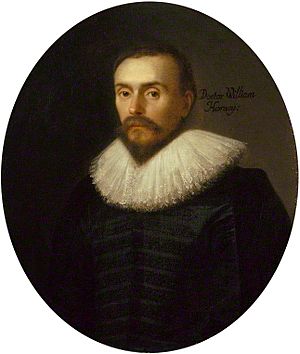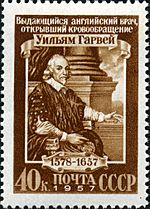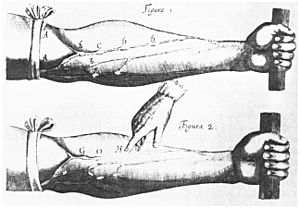William Harvey facts for kids
Quick facts for kids
William Harvey
|
|
|---|---|

Portrait attributed to Daniël Mijtens, c. 1627
|
|
| Born | April 1, 1578 Folkestone, Kent, England
|
| Died | June 3, 1657 (aged 79) Roehampton, London, England
|
| Education | Gonville and Caius College, Cambridge University of Padua (M.D., 1602) |
| Known for | De Motu Cordis, 1628 (translated as Anatomical Account of the Circulation of the Heart and Blood in 1928) on systemic circulation |
| Scientific career | |
| Fields | Medicine Anatomy |
| Doctoral advisor | Hieronymus Fabricius |
| Influenced | René Descartes |
| Signature | |
 |
|
William Harvey (born April 1, 1578 – died June 3, 1657) was an English doctor. He made very important discoveries about the human body. He was the first person to fully explain how blood moves around the body. He showed how the heart pumps blood to the brain and all other parts of the body.
Contents
Early Life and School
William Harvey was the oldest of nine children. He had six brothers and two sisters. His father, Thomas Harvey, was the mayor of Folkestone, a town in England.
William started learning Latin at a young age in Folkestone. He then went to the King's School in Canterbury for five years. In 1593, he went to Gonville and Caius College, Cambridge to study.
He earned his first degree, a Bachelor of Arts, in 1597. After that, he traveled through France and Germany. In 1599, he arrived in Italy and joined the University of Padua.
While studying there, he became friends with his teacher, Fabricius. He read Fabricius's book, De Venarum Ostiolis, which was about valves in veins. This book made Harvey very interested in anatomy, the study of the body's structure. On April 25, 1602, at age 24, Harvey earned his Doctor of Medicine degree from Padua.
Becoming a Doctor and Marriage
After finishing his studies, Harvey came back to England. He started working as a doctor. On October 5, 1604, he joined the Royal College of Physicians. This was a very important group for doctors.
Soon after, Harvey married Elizabeth Browne. She was the daughter of another doctor, Lancelot Browne. William and Elizabeth did not have any children.
On June 5, 1607, Harvey became a Fellow of the Royal College of Physicians. This allowed him to add "FRCP" after his name. He then started working at St. Bartholomew's Hospital. He worked there for most of his life.
In 1615, Dr. Harvey was chosen to be a Lumleian lecturer. This special job meant he gave talks to other doctors. The goal was to share new knowledge about anatomy across England. His notes from these lectures are still kept safe in the British Museum.
Doctor to the King
Dr. Harvey continued his lectures and cared for patients. His work caught the attention of King James I. On February 3, 1618, Harvey became the king's 'Physician Extraordinary'. This meant he was a special doctor for the king.
Books, Travel, and Work
In 1628, Harvey published his most famous book, De Motu Cordis. This book explained his new ideas about how blood moves in the body. Many other doctors did not agree with him at first. They even criticized his ideas. However, he kept his important roles at the College of Physicians. He was even chosen as their Treasurer.
When Harvey was 52, the king asked him to travel with the Duke of Lennox. This trip lasted three years. They traveled through France and Spain during a time of war and plague.
He returned to England in 1632. He then became the personal doctor for King Charles I. During this time, the English Civil War began. Harvey helped care for wounded soldiers. He followed King Charles to Oxford. In 1642, he was made "Doctor of Physic" there. Later, in 1645, he became the Warden of Merton College.
Harvey's Later Years and Death
By 1645, Harvey was 68 years old. He had no children. He had also lost three of his brothers and his wife. He retired from St. Bartholomew's Hospital and his other jobs.
William Harvey died on June 3, 1657. He passed away at his brother Eliab's house in Roehampton. In his will, he left his money and belongings to his family and the Royal College of Physicians. He was buried in St. Andrew's Church in Hempstead, England.
De Motu Cordis: How Blood Moves
In 1628, Dr. Harvey published his 72-page book, Exercitatio Anatomica de Motu Cordis et Sanguinis in Animalibus. This book explained how blood circulates throughout the body. Harvey had studied many different animals. He realized that the heart pumps blood in a single, continuous loop. This loop uses both arteries and veins. Harvey knew that people might not believe his new idea. He was right; it took about 20 years for his theory to be accepted by most doctors.
Before Harvey, the ancient doctor Galen was the main authority on medicine for hundreds of years. Galen believed that veins and arteries were two separate systems. He thought the heart made heat, and the lungs cooled the blood. Years before Harvey, a few other scientists had similar ideas. However, their discoveries were either lost or ignored. These scientists included Ibn al-Nafis and Michael Servetus.
On Animal Generation: Where Life Comes From
Harvey's other important book was Exercitationes de generatione animalium. It was published in 1651. In this book, he described how a hen's egg develops. He showed that omne vivum ex ovo, which means "all life comes from the egg."
He explained that some animals lay eggs that hatch outside the mother's body. These are called oviparous animals. Other animals have eggs that stay inside the mother, leading to a live birth. These are called viviparous animals. Harvey's work proved that the old idea of spontaneous generation was wrong. Spontaneous generation was the belief that living things could just appear from non-living matter.
William Harvey's Legacy

William Harvey's special pointing rod is on display today. It is made of whalebone with a silver tip. He used it to point to things during his lectures. You can see it in the museum of the Royal College of Physicians in London.
Many medical places, groups, and clubs are named after him. There is also a statue of him in his hometown of Folkestone, Kent. The Royal College of Physicians of London holds an annual lecture called the Harveian Oration. William Harvey himself started this lecture in 1656.
William Harvey Quotes
- “All we know is still infinitely less than all that remains unknown.”
- “Nature is a volume of which God is the author.”
- “Only by understanding the wisdom of natural foods and their effects on the body, shall we attain mastery of disease and pain, which shall enable us to relieve the burden of mankind.”
- “For the concept of a circuit of the blood does not destroy, but rather advances traditional medicine.”
- “No human being may acquire knowledge without diligence.”
Interesting Facts About William Harvey
- William had six brothers and two sisters. Five of his brothers became successful merchants in London.
- While at the University of Padua, Harvey attended lectures in a special anatomical theater. It was built in 1594 and is still there today. It is a small room, about 25 by 30 feet. There is an oval pit in the middle where the professor would speak and show things.
- Hieronymus Fabricius, one of Harvey's teachers, had already found the one-way valves in veins. But he wasn't sure what they were for. Harvey later proved that these valves stop blood from flowing backward.
- One of Harvey’s main experiments was about how much blood flows through the heart.
- Before Harvey’s discoveries, Western doctors believed the liver was the source of blood movement.
- His wife, Elizabeth Browne, was the daughter of Dr. Lancelot Browne. He was the doctor for Queen Elizabeth I, King James I, and Queen Anne of Denmark.
- King Charles I was very interested in Harvey’s research. He even gave Harvey animals for his experiments.
- In his later life, Harvey suffered from gout, kidney stones, and insomnia.
Images for kids
-
William Harvey, after a painting by Cornelius Jansen
-
Bust of William Harvey at the Royal College of Physicians, London
See also
 In Spanish: William Harvey para niños
In Spanish: William Harvey para niños
- Miguel Servet
- Amato Lusitano – Portuguese 16th-century physician, also credited with the discovery of the circulation of the blood
- Josephus Struthius
- Scientific revolution
- List of multiple discoveries







